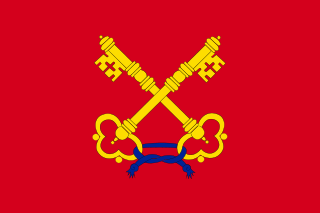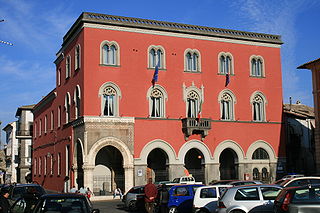
Pope Benedict XII, born Jacques Fournier, was head of the Catholic Church from 30 December 1334 to his death, in April 1342. He was the third Avignon pope and reformed monastic orders and opposed nepotism. Unable to remove his capital to Rome or Bologna, Benedict started the great palace at Avignon. He settled the beatific vision controversy of Pope John XXII by stating that souls may attain the "fullness of the beatific vision" before the Last Judgment. Despite many diplomatic attempts with Emperor Louis IV to resolve their differences, Benedict failed to bring the Holy Roman Empire back under papal dominance. He died 25 April 1342 and was buried in Avignon.

Pope Urban VII, born Giovanni Battista Castagna, was head of the Catholic Church, and ruler of the Papal States from 15 to 27 September 1590. His papacy was the shortest in history, during which a smoking ban encompassing churches across the world was implemented.

Pope Paul III, born Alessandro Farnese, was head of the Catholic Church and ruler of the Papal States from 13 October 1534 to his death, in November 1549.

The Papal States, officially the State of the Church, were a series of territories in the Italian Peninsula under the direct sovereign rule of the pope from 756 until 1870. They were among the major states of Italy from the 8th century until the unification of Italy, between 1859 and 1870.

The Quirinal Palace is a historic building in Rome, Italy, one of the three current official residences of the President of the Italian Republic, together with Villa Rosebery in Naples and the Tenuta di Castelporziano, an estate on the outskirts of Rome, some 25 km from the centre of the city. It is located on the Quirinal Hill, the highest of the seven hills of Rome in an area colloquially called Monte Cavallo. It has served as the residence for thirty popes, four kings of Italy and twelve presidents of the Italian Republic.

The Comtat Venaissin, often called the Comtat for short, was a part of the Papal States (1274–1791) in what is now the Provence-Alpes-Côte d'Azur region of France.

The properties of the Holy See are regulated by the 1929 Lateran Treaty signed with the Kingdom of Italy. Although part of Italian territory, some of them enjoy extraterritoriality similar to those of foreign embassies.

The Lateran Palace, formally the Apostolic Palace of the Lateran, is an ancient palace of the Roman Empire and later the main papal residence in southeast Rome.

Montone is a comune (municipality) in the Province of Perugia in the Italian region Umbria, located about 35 km north of Perugia. It is a member of the I Borghi più belli d'Italia association.

Campagnano di Roma is a comune (municipality) in the Metropolitan City of Rome in the Italian region of Latium, located about 30 kilometres northwest of Rome. It was first mentioned in 1076, having been carved out of the great estate assembled on the Roman pattern by Pope Adrian I, ca. 780, his Domusculta Capracorum. In medieval times, Campagnano di Roma was on the via Francigena. Here, Sigeric, Archbishop of Canterbury, sojourned on his return journey from Rome about 990.

Tivadar is a village in Szabolcs-Szatmár-Bereg county, in the Northern Great Plain region of eastern Hungary.
Tiszanagyfalu is a village in Szabolcs-Szatmár-Bereg county, in the Northern Great Plain region of eastern Hungary.
Kára is a village in Somogy county, Hungary.

A rocca is a type of Italian fortified stronghold or fortress, typically located on a hilltop, beneath or on which the inhabitants of a historically clustered village or town might take refuge at times of trouble. Generally under its owners' patronage, the settlement might hope to find prosperity in better times. A rocca might in reality be no grander than a fortified farmhouse. A more extensive rocca would be referred to as a castello.
Saint Edistus is venerated as a martyr and saint by the Roman Catholic and Eastern Orthodox churches. His legend states that he was martyred on the Via Laurentina and his passio places his martyrdom during the reign of Nero, on October 12, 60 AD.

Abaucourt is a commune in the Meurthe-et-Moselle department in northeastern France.

Sajókeresztúr is a village in Borsod-Abaúj-Zemplén County in northeastern Hungary, about seven kilometres north of Miskolc, between Szirmabesenyő and Sajóecseg. It has a kindergarten, a primary school and a football team.

Llandderfel is a village and a sparsely populated community in Gwynedd, Wales, near Bala, formerly served by the Llandderfel railway station. The community also includes the settlements of Glan-yr-afon, Llanfor, Cefnddwysarn and Frongoch. The Community population taken at the 2011 census was 1,095.

The Principality of Pontecorvo was a principality in Italy created by Napoleon after he became King of Italy in 1805. It consisted of the Italian commune of Pontecorvo, an exclave of the Papal States from 1463 within the territory of the Kingdom of Naples.
Cum saepe accidere was a papal bull issued by Pope Clement VIII on 28 February 1592, which decreed that the Jews of Avignon were forbidden to trade "new commodities" in public places in order to put them at an economic disadvantage.















